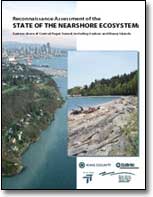Reconnaissance Assessment of the State of the Nearshore Report Including Vashon and Maury Islands (WRIAs 8 and 9)

Department of Natural Resources,
May 2001
The State of the Nearshore report is available in Adobe Acrobat format. For help with viewing Adobe Acrobat, please see the Acrobat help page.
About This Report
The State of the Nearshore Report (SONR) is the first attempt to provide a comprehensive summary and an assessment of the state of our current knowledge of ecological processes and conditions, natural resources, and ecosystem health in nearshore portions of Water Resource Inventory Areas (WRIAs) 8 and 9. The SONR is a preliminary assessment that compiles readily available literature, data, and information on selected habitats and species identified by a convened panel of scientists and resource managers from local, state, and federal agencies, the University of Washington, Native American Tribes, and other entities. An exhaustive literature search and assessment have not been undertaken.
The intent of this report is to have, in one place, a summary of the nearshore ecosystem characteristics in WRIAs 8 and 9 that will serve as a foundation for future technical work and decision making. The report has several specific purposes/objectives:
- Provide a basis for nearshore watershed and salmon recovery planning.
- Provide direction for future technical work through identification of data gaps.
- Serve as a resource to researchers, planners, and managers dealing with nearshore issues in WRIAs 8 and 9.
Additionally, the contents of this report may be of value to other regions and resource managers interested in the nearshore ecosystem.
The following text files are available for downloading:
Best viewed with Adobe Acrobat Reader 4.0 or greater. Click here for help with Adobe Acrobat
1. Executive Summary
Summarizes complete report, 67 pages (648 KB)
2. Complete State Of The Nearshore Report
- Cover, Front Matter and List of Acronyms/Abbreviations (370 KB)
- Chapter 1: Introduction (215 KB)
- Chapter 2: Conceptual Model Of The Nearshore (238 KB)
- Chapter 3: Features Of Puget Sound Region: Oceanography And Physical Processes (343 KB)
- Chapter 4: Nutrient Dynamics And Other Water Properties (158 KB)
- Chapter 5: Primary Productivity Dynamics And Rates (118 KB)
- Chapter 6: Food Web (356 KB)
- Chapter 7: Selected Nearshore Habitat Types (633 KB)
- Chapter 8: Selected Fishes (569 KB)
- Chapter 9: Selected Invertebrates (278 KB)
- Chapter 10: Shoreline Conditions (391 KB)
- Chapter 11: Elliott Bay And The Duwamish River Estuary (1.16 MB)
- Chapter 12: Conclusions And Recommendations (216 KB)
- Chapter 13: Literature Cited (377 KB)
- Appendix -- Data Gaps And Key Findings (323 KB)
The following figure files are available for downloading:
Best viewed with Adobe Acrobat Reader 4.0 or greater. Click here for help with Adobe Acrobat
| Figure 1 | Study Area (780 KB) |
| Figure 2 | Nearshore Section Illustrating Typical Zonation (591 KB) |
| Figure 3 | Nearshore Environment Habitat Types (270 KB) |
| Figure 4 | Simplified Conceptual Model of the Puget Sound Nearshore Ecosystem (375 KB) |
| Figure 5 | Riverine/Estuarine Ecosystems (18 KB) |
| Figure 6 | Conceptual Model of Salmonid Use of the Nearshore Environment (18 KB) |
| Figure 7 | Potential Stressors in the Coastal Ecosystems of the Pacific Northwest and Associated Ecological, Economic, and Social Impacts (35 KB) |
| Figure 8 | General Conceptual Model, with Example for Evaluating Effects of Shoreline Armoring and Mitigation Actions (25 KB) |
| Figure 9 | WRIA 8 Nearshore Bathymetry and Topography (1.34 MB) |
| Figure 10 | WRIA 9 Nearshore Bathymetry and Topography (2.64 MB) |
| Figure 11 | WRIA 8 Nearshore Drift Cells (422 KB) |
| Figure 12 | WRIA 9 Nearshore Drift Cells (432 KB) |
| Figure 13 | Simplified Example of a Detritus-based Shallow Subtidal Food Web in Puget Sound (249 KB) |
| Figure 14 | Eelgrass and Kelp Areas Mapped Using Side-Scan Sonar (300 KB) |
| Figure 15 | Eelgrass and Kelp Shoreline Lengths (796 KB) |
| Figure 16 | Fucus and Ulva Shoreline Lengths (805 KB) |
| Figure 17 | Conceptual Model of Marine Riparian Functions (417 KB) |
| Figure 18 | Salmonid Use of the Nearshore Environment (1.93 MB) |
| Figure 19 | Known Forage Fish Spawning Areas (903 KB) |
| Figure 20 | Distribution of Selected Invertebrates (854 KB) |
| Figure 21 | Historic channel/Shore Locations, Upland Forest and Wetlands of the Duwamish River Estuary (235 KB) |
| Figure 22 | Artificial Channel Constraints and Shoreline Modifications - Elliott Bay & Duwamish Waterway (287 KB) |
| Figure 23 | Artificial Channel Constraints and Large Woody Debris - Map 1 of 3 (109 KB) |
| Figure 24 | Artificial Channel Constraints and Large Woody Debris - Map 2 of 3 (109 KB) |
| Figure 25 | Artificial Channel Constraints and Large Woody Debris - Map 3 of 3 (107 KB) |
| Figure 26 | Yearly Minimum Dissolved Oxygen (mg/L) in the Duwamish River (41 KB) |
| Figure 27 | Yearly Average Ammonia Nitrogen (mg/L) in the Duwamish River (35 KB) |

 Translate
Translate